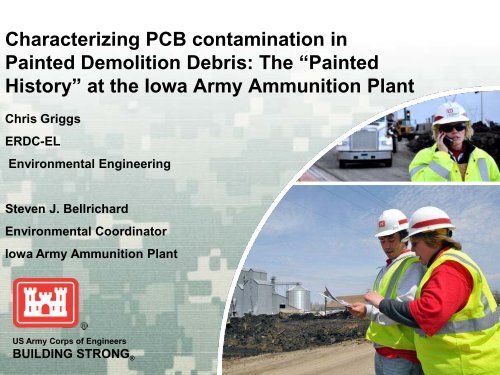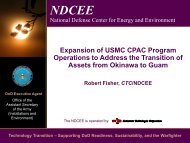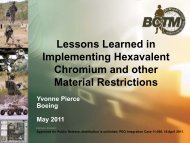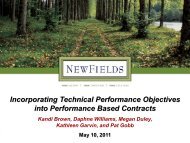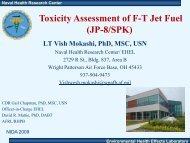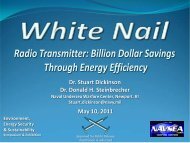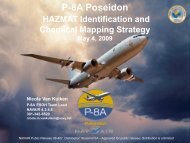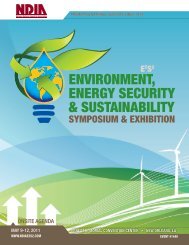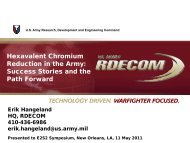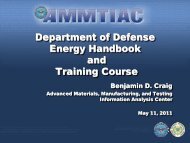12241 - E2S2
12241 - E2S2
12241 - E2S2
Create successful ePaper yourself
Turn your PDF publications into a flip-book with our unique Google optimized e-Paper software.
Characterizing PCB contamination inPainted Demolition Debris: The “PaintedHistory” at the Iowa Army Ammunition PlantChris GriggsERDC-ELEnvironmental EngineeringSteven J. BellrichardEnvironmental CoordinatorIowa Army Ammunition PlantUS Army Corps of EngineersBUILDING STRONG ®
Why Characterize PCBs in Painted DemolitionWaste?Answer: EPA Reinterpreting TSCA?‣ Reinterpretation: EPA Region 7, at Iowa Army Ammunition Plant(IAAAP), wants to regulate the painting of buildings with paintcontaining PCBs as if the PCBs were spilled/released‣ New Interpretation Would: Turn Demolition into Remediation‣ Interpretation Dispute Did (At IAAAP): Reduction in DemolitionScope and loss of $10 million in potential Facility ReductionProgram (FRP) FundingBUILDING STRONG ®
AgendaIAAAP‣ 40 CFR 761.3 Definition PCB Bulk Product vs Remediation‣ History PCBs in Paint‣ FRP, PCB in Paint, and EPA History at IAAAPERDC‣ IAAAP ERDC Sampling‣ ERDC Summary of DataBUILDING STRONG ®
40 CFR 761.3 DefinitionPCB Bulk Product WastePCB bulk product waste means waste derived from manufacturedproducts containing PCBs in a non-liquid state, at any concentrationwhere the concentration at the time of designation for disposal was≥50 ppm PCBs. PCB bulk product waste does not include PCBs orPCB Items regulated for disposal under § 761.60(a) through (c), §761.61, § 761.63, or § 761.64. PCB bulk product waste includes, butis not limited to:(1) Non-liquid bulk wastes or debris from the demolition of buildingsand other man-made structures manufactured, coated, or servicedwith PCBs. PCB bulk product waste does not include debris fromthe demolition of buildings or other man-made structures that iscontaminated by spills from regulated PCBs which have not beendisposed of, decontaminated, or otherwise cleaned up inaccordance with subpart D of this part.BUILDING STRONG ®
40 CFR 761.3 DefinitionPCB Remediation WastePCB remediation waste means waste containing PCBs as a result ofa spill, release, or other unauthorized disposal, at the followingconcentrations: Materials disposed of prior to April 18, 1978, that arecurrently at concentrations ≥ 50 ppm PCBs, regardless of the concentrationof the original spill; materials which are currently at any volume orconcentration where the original source was ≥ 500 ppm PCBs beginning onApril 18, 1978, or ≥ 50 ppm PCBs beginning on July 2, 1979; and materialswhich are currently at any concentration if the PCBs are spilled or releasedfrom a source not authorized for use under this part. PCB remediationwaste means soil, rags, and other debris generated as a result of any PCBspill cleanup, including, but not limited to: (1) soil, gravel, sediment (2)sewage sludge (3) Buildings and other man-made structures (suchas concrete floors, wood floors, or walls contaminated from aleaking PCB or PCB-Contaminated Transformer), poroussurfaces, and non-porous surfaces.BUILDING STRONG ®
History of PCBs in Paint‣ PCB’s have been historically used as a plasticizer in building materials.‣ Principally Aroclor 1254 was used in the past in paint when thermal andchemical resistance was desired. Paint and lacquer formulations specifiedup to 10% Aroclor 1254 yielding possible dry weights of up to 25% or250,000 mg/kg.‣ At IAAAP, a large caliber load assemble and pack facility built in the 1940’s,PCBs in paint range from 0 – 24,000 mg/kgBUILDING STRONG ®
History of FRP, PCBs in Paint and EPA at IAAAP‣ 2005/6 - FRP Demolished Line 7. Burning of an explosive contaminatedbay in Building 7-36, to eliminate the explosive hazard, was stopped byRegion 7 EPA because of the unknown properties of the paint. Two paintsamples where collected and analyzed for various parameters includingPCBs. Total PCB results were 4,300 and 24,000 mg/kg, all of which whereAroclor-1254.Note: EPA’s position at this time was that all PCBs needed to be removed priorto burning or the Army conduct a risk based assessment. The performancebased contractor removed the paint by mechanical methods. EPA thenrequired a core sample be collected. One core sample was, result 0.8mg/kg Total PCB.BUILDING STRONG ®
History of FRP, PCBs in Paint and EPA at IAAAP‣ April 2008 – EPA disagrees with TSCA portion of demolition work plan.Plan states non metallic painted demolition debris will be managed as PCBBulk Product Waste (i.e. no samples; waste disposed in a Municipal SolidWaste Landfill). EPA requests paint and substrate samples be collectedfrom the “Paint Histories” of buildings slated for demolition.EPA’s “Paint History”: Each paint color per building per buildingmaterial/substrate.‣ July 2008 – Sample paint and substrate “Paint Histories” of 3 inactive nonexplosivelines (33 Buildings, 102 Samples). Results 5 “Paint Histories” (5samples ,4 buildings) contain substrate greater than 50 mg/kg PCB.EPA Redefines/Reinterprets TSCA: Demolition waste painted with paintcontaining PCB’s is PCB Remediation Waste if the substrate contains 50 orgreater mg/kg PCBs.BUILDING STRONG ®
2008 Results (4 Buildings Substrate >50 ppm)Building # Paint Result Substrate Result Substrate Material Paint Color(mg/kg or ppm) (mg/kg or ppm)5A-21 795 210 plaster Beige on Red on Green5A-26 2670 76 concrete Yellow5B-137-2 1040 139 gypsum Blue5B-137-2 1100 52 chipboard yellow9-64 7960 218 concrete GreenBUILDING STRONG ®
History of FRP, PCBs in Paint and EPA at IAAAP‣ Between July 2008 and 2009 – Letters, descoping, plan to mobilize, IowaDepartment of Natural Resources (IDNR) states that all waste with paint orsubstrate results greater than 50 mg/kg PCB (21 Buildings, 46 Samples)can not be disposed of in Iowa. IDNR does agree that the waste is thepainted wall, not the paint or the substrate, and recommends “composite”sampling (i.e. the painted wall).‣ July 2009 – Composite sample the non metallic “Paint Histories” with paintresults greater than 50 mg/kg (38 Samples, 19 Buildings). Results indicate12 “Paint Histories” (12 samples, 8 Buildings) contain levels greater than 50mg/kg PCB.BUILDING STRONG ®
2009 Results (8 Buildings Composite > 50 ppm)Building #CompositeSample Resultfor PCBs (mg/kgor ppm)SubstrateMaterial2008 PaintResult2008 SubstrateResult5A-25 408 N Concrete 7770 185A-26 143 Concrete 2670 765A-55 195.4 J Plaster 4290 ND5B-21 68.2 Plaster 1930 ND5B-55 (Red) 64.5 J Plaster 2710 195B-55 (Green) 366 N Plaster 2820 125B-137 (Blue) 194 N Gypsum 1040 1395B-137(Yellow) 198 N Chipboard 1100 525B-137(Blue) 660 J Chipboard 605 159-62 606 J Concrete 117 ND9-64 (green) 1365 Wood 3190 ND9-64(Green oRed)462.2 J Concrete 7960 218BUILDING STRONG ®
History of FRP, PCBs in Paint and EPA at IAAAP‣ Between July 2009 and April 2010 – more letters, scope reduction,demolish Line 9 and Line 5A buildings with both substrate and compositesample “Paint History” results less than 50 mg/kg PCB. Discover “core”samples not representative.‣ May 2010 – EPA Site Visit and ERDC resampling.BUILDING STRONG ®
ERDC Site Investigation at IAAAP‣ A case study at Iowa Army Ammunition Plant IAAAP was performed withthe “Paint Histories” in which the walls of industrial concrete and porousbuilding materials were sampled and analyzed for PCB contamination‣ November 2010 ERDC re-sampled the buildings using a coring machine,as opposed to previous sampling efforts that used hand tools. The 2008 and2009 concrete samples were not representative of the waste stream.BUILDING STRONG ®
ERDC Composite Defined:Multiple Paint layersPlaster between paintand concreteUnderlying concreteExterior BrickBUILDING STRONG ®
PCB in Paint and SubstrateSome of thesebuilding materialswere over 1 foot thick.BUILDING STRONG ®
Other Porous Media (wood, gypsum, chipboard)BUILDING STRONG ®
2009 Composites Samples Not RepresentativeBUILDING STRONG ®
Samples Not RepresentativeProblem(s):‣ The 2008 and 2009 concrete samples were not representative of the wastestream.‣ The 2009 composite sampling report states that 1 inch in diameter by ½ to¾ inch deep core samples were collected. However, some of these buildingmaterials were over 1 foot thick.‣ A site visit was conducted to assess the 2008 sampling locations and it wasdiscovered that the substrate samples had only the first couple of millilitersof material collected, apparently by hammer and chisel.BUILDING STRONG ®
Data Irregularity‣ Example, composite sample of concrete building material in building 9-62.The composite sample result is 606 ppm PCB, which is higher than thepaint sample result of 117 ppm. Bottom line, the data is suspect.‣ Impact: These data are at the heart of an EPA/Army informal dispute that isover 2 years old, has been elevated to both party’s headquarters, and is stillnot resolved.‣ This conflict has made the site ineligible for millions of dollars in FRP funds‣ FRP is OMA-funded compared to BRAC and MCA-funded demolition. FRPaccounts for about 20% of what the Army does.‣ If the problem hits FRP, what effects could it have on the other 80% ofArmy-funded, not to speak at all about Air Force, Navy, NASA, etc.?BUILDING STRONG ®
PCB bulk waste product OR PCB remediation waste?Building #CompositeSample Resultfor PCBs (mg/kgor ppm)SubstrateMaterial2008 PaintResult2008 SubstrateResult5A-25 408 N Concrete 7770 185A-26 143 Concrete 2670 765A-55 195.4 J Plaster 4290 ND5B-21 68.2 Plaster 1930 ND5B-55 (Red) 64.5 J Plaster 2710 195B-55 (Green) 366 N Plaster 2820 125B-137 (Blue) 194 N Gypsum 1040 1395B-137(Yellow) 198 N Chipboard 1100 525B-137(Blue) 660 J Chipboard 605 159-62 606 J Concrete 117 ND9-64 (green) 1365 Wood 3190 ND9-64(Green oRed)462.2 J Concrete 7960 218Samples Not Representative - The 2008 and 2009 concrete samples werenot representative of the waste stream.BUILDING STRONG ®
Impact:‣Site ineligible for millions of dollarsin FRP funds‣ Buildings remain at siteBUILDING STRONG ®
PCB bulk waste product OR PCB remediationwaste?‣ EPA TSCA guidance states painted demolition debris is PCB bulk wasteproduct and may be disposed of in a municipal solid waste‣ EPA region 7 claims PCB remediation waste as PCB’s from the paint mayhave migrated into the substrate constituting a “spill”‣ Army does not agree that painting a building material constitutes a spill orrelease, nor does the physical processes of paint drying and settling into thepores of a structural material constitute a release.BUILDING STRONG ®
ERDC Sampling StrategyThrough providing an accurate representation of the extent of PCBcontamination on painted building materials, a scientifically validcharacterization can be providedBUILDING STRONG ®
PCB in Paint and SubstrateThe 2009 compositesampling report statesthat 1 inch in diameterby ½ to ¾ inch deepcore samples werecollected.2010RepresentativeSampleBUILDING STRONG ®
2008 Results vs. 2010 Results (3 of 4 BuildingsBelow 50mg/kg action limit)Building #2008 PaintPCB Result(mg/kg)2008SubstrateResult(mg/kg)SubstrateMaterialPaint Color2010 PaintResult (mg/kg)2010SubstrateResult(mg.kg)5A-21 795 210 plaster Beige on Red 240 0.35on Green5A-26 2670 76 concrete Yellow 10,000 9.65B-137-2 1040 139 gypsum Blue 210 2605B-137-2 1100 52 chipboard yellow 450 1709-64 7960 218 concrete Green 950 0.99BUILDING STRONG ®
Project SummaryWhere surface paint concentrations of 290mg/kg were observed, only 2 mg/Kg waspresent in the plaster directly beneath thepaint.gradients in concentration with depthwere not observed in the data‣ All 2010 substrate sampling results for plaster and concrete are lessthan 50 mg/kg‣ The 2010 results are orders of magnitude less than the 2008‣ Bottom line, no indication of migrationBUILDING STRONG ®
Conclusions‣ True sample cores were taken that revealed surface paint as the source ofPCB contamination with negligible diffusion into underlying concrete, asdeclining gradients in concentration with depth were not observed in thedata.‣ Consequently the potential for migration into the underlying Substrate differsconsiderably from a scenario such as transformer oil spills onto a concreteslab.‣ However samples from wood and other porous materials (e.g. gypsum,chipboard) indicated diffusion into the substrate.‣ Such information has considerable regulatory and financial significance inassessing whether the site is classified as PCB bulk waste product or PCBremediation waste.BUILDING STRONG ®
Questions?BUILDING STRONG ®


